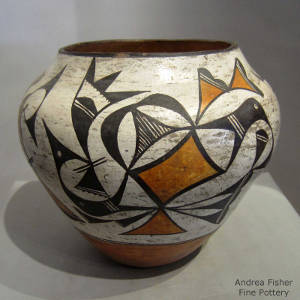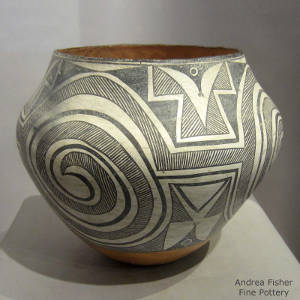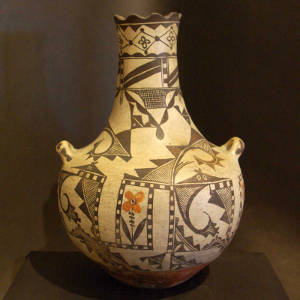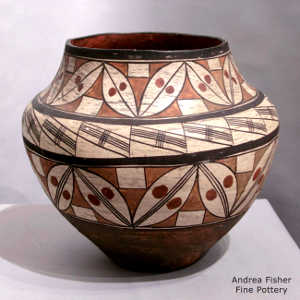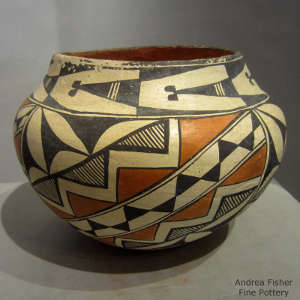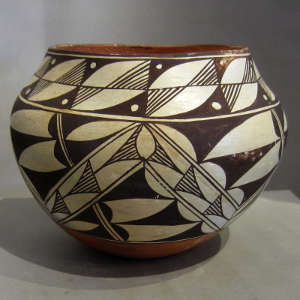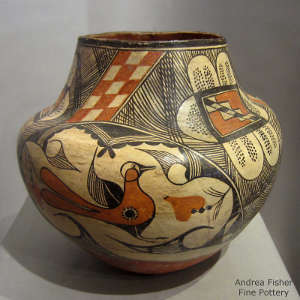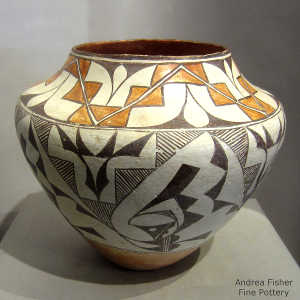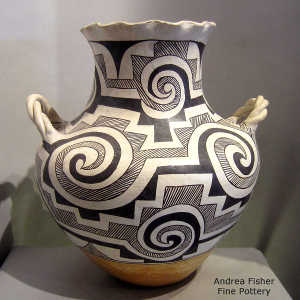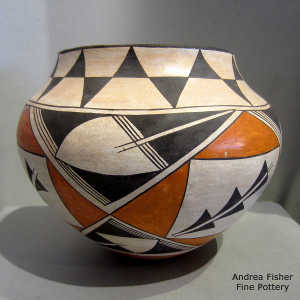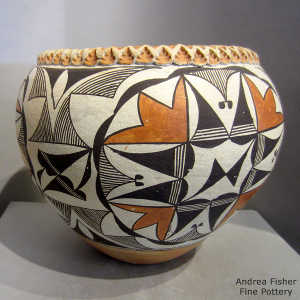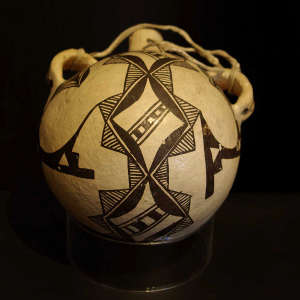Acoma Pueblo
- Aku: The place that always was
- Language: Western Keres
- Size: 375,000 Acres
- Population: About 5,000
James Paytiamo wrote a book in the 1930s that combined his knowledge of his tribal customs with the tales he'd heard from tribal elders. Flaming Arrow's People is an account of the traditions of the Acoma people and how they relate to their journey through time.
Among the Acoma people many of the traditional concepts of community and culture have not changed over the years, even though recent modernization has brought some severe changes to the tribe. Many of the tribal customs practiced today were practiced long before the Spanish conquest.
Today only about 30 people, mostly children and elderly, live full time in Old Acoma on the mesa top. There is no running water, electricity or sewage disposal in the village. The village is not a UNESCO World Heritage site because there have been a few modern improvements allowed (like indoor wood stoves with metal chimneys). However, virtually every family living on the Acoma reservation has an ancestral home on the mesa top which they maintain and occupy during traditional pueblo ceremonies. Most Acomas live full time in the villages below.
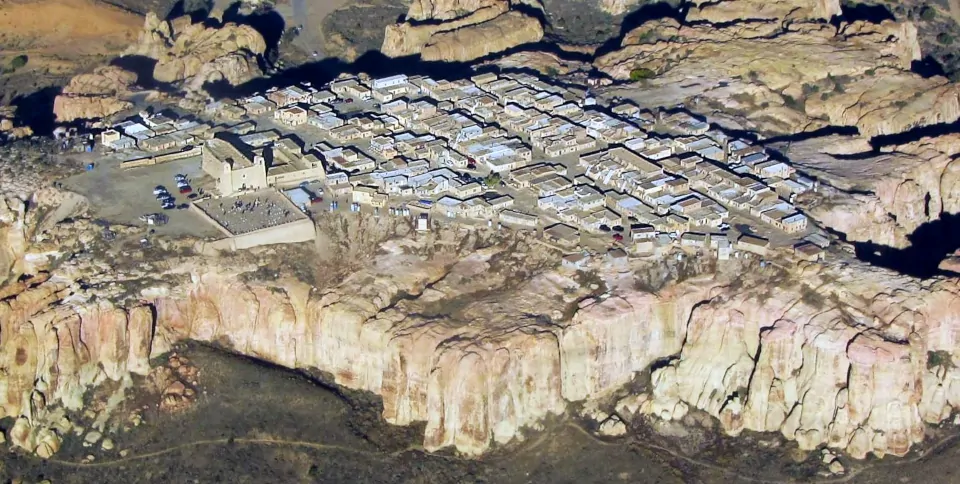
An aerial view of Sky City
When a tribal member is honored with one of the tribe's administrative or religious posts, they and their immediate family spend the next year living on the mesa top for the time of service. Virtually all administrative and religious posts are held by men. Descent is matrilineal and virtually all property is held by women. The highest post in the pueblo hierarchy is the Cacique, or religious chief. He holds the post for life and is immune from any challenge, except he can be removed from office if so ordered by a Two-Spirit woman.
Acoma Pueblo History
Located about 45 miles west of Albuquerque, Acoma Pueblo consists of Sky City atop Acoma Mesa and the villages of McCartys and Acomita stretching out along the Rio San José, a tributary of the Rio Grande. Interstate 40 crosses tribal property on the northwest edge of the reservation (near Acomita and McCartys) and it's there that the pueblo has established its Sky City Casino and Hotel, Sky City Cultural Center and Haaku Museum and tourist services operations. Acoma Mesa itself is several miles away (and the signage to get there is not very good).
Acomita and McCartys are also close to the train station at Old Laguna. That was very important for Acoma potters in the days after the railroad arrived and before Interstate 40 was built.
Acoma's Sky City, Taos Pueblo and Hopi's Old Oraibi all contend to be the oldest continuously inhabited settlements in the United States. Each date their founding back to the 12th Century CE and earlier.
Oral histories among the Acoma people indicate the tribe began living on the mesa top more than two thousand years ago. As the mesa top is still a living village, almost no archaeological excavation has happened. Modern methods of dating have never been applied to anything of consequence around Acoma Pueblo itself. That said, there has been significant archaeological work done around the area and the trails left by the pottery sherds, discarded everywhere, tell a story, too.
The 376-foot-high sandstone mesa where Acoma Pueblo is built once provided excellent defense against Apache and Diné raiding parties. But the people located their village on top of the mesa several hundred years before the Diné and Apache came into the area. The Diné and the Apache arrived about the same time as the Spanish.
Before the Spanish arrival
The 12th century CE saw the height (and collapse) of the Mimbres Mogollon society in the Mimbres Valley, on the south side of the Gila Mountains to the south. When the Mimbres people left that area, some went north, some went west to the Rio Salado and Hohokam pueblos. Many seem to have gone south to Paquimé in what is now northern Chihuahua State, Mexico. The Jornada Mogollon people lived in the area stretching from the Tularosa Basin westward to the area of Springerville in Arizona and southward to Paquimé. The Jornada Mogollon also left behind the large collection of petroglyphs at the Three Rivers Petroglyph Site at the northern end of the Tularosa Basin.
Modern archaeologists say that katsina and warfare imagery first appeared on Southwestern pottery in the mid-1300s. Pottery Mound (ruins from the 1300s, located just east of Acoma and west of Isleta) has wall murals depicting relatively modern Native Americans holding scarlet macaws. The mid-1300s was also the time of the birth of the sacred clown (Koshare) and medicine (Bear) clans in Pueblo societies.
The late-1200s saw Mesa Verde being abandoned with tribes and clans moving either east toward the Jemez Mountains and Rio Grande Valley or southwest to the Hopi mesas. Pottery Mound, Zuni, Acoma and Laguna flourished. Trade routes all across the southwest were busy. Sikyátki and Kawaika'a were founded and Awat'ovi, Oraibi and Walpi grew larger. Then competition for trade heated up, religious divisions grew larger and the weather dried up again.
The Mogollon built the large pueblo at Paquimé, along the Rio Palanganas in northern Mexico. They were surrounded by smaller pueblos and outlying villages. They grew wealthy on trade: turquoise going south, seashells, copper bells and colored birds going north. The trade in macaws and green-fronted parrots was so profitable, they figured out how to birth and raise them at Paquimé. Then it seems they fought a war with a tribe from the south and lost. In that loss they lost their cities, their agricultural fields, their trade routes and their culture. Their culture collapsed overnight and Paquimé was virtually abandoned by about 1450. Even the Mogollon pueblos as far north as east-central Arizona were abandoned by 1450 or so.
At least that's one of the educated conjectures as to what happened to the residents of Paquimé in the mid 1400s. Globally speaking, there was an as-yet-unidentified volcanic eruption in 1452/3 that led quickly to several years of ash-filled skies and deep drought, again. Crops failed, wars broke out, people died, or migrated. The trails left by the prehistoric trade in turquoise tell a story of their own.
By the time the Spanish began exploring the interior of Chihuahua and Francisco de Ibarra stumbled across Paquimé in 1565, that largest pueblo ever constructed in the Southwest had already been abandoned for more than 100 years. Nearby tribal members (a more nomadic tribe than most in the area) indicated the inhabitants of the city had lost a war several generations earlier and were scattered to the wind afterwards. Other local stories say the people migrated to the west to a more forgiving desert landscape.
When we follow the pottery, the designs and the social changes that came with that, it looks as though much of the Paquimé culture flowed north, even into the northern Rio Grande pueblos and the land of the Hopis. The most modern archaeological research indicates some elements of Puebloan religions and societal structures had begun flowing north a few hundred years before that from sources in southern Mexico and Central America.
The Spanish Colonization
In 1540, Captain Hernando de Alvarado and Fray Juan Padilla arrived at Acoma with an escort of soldiers. Hernando later claimed no army would ever be strong enough to capture the village built as it was up on a high rock with steep sides in every direction.
In 1598 Don Juan de Oñaté was sent to colonize the area. When he and his troops came to Acoma, Oñaté tried to administer the Act of Obedience and Homage: a formal ceremony in which the Acomas, misunderstanding what was happening, gave their oath to obey the King of Spain and his Christian God. When they realized what had happened, the Acoma people responded by ambushing a group of Spanish soldiers and killing eleven of them, including Oñaté's nephew.
The Spanish responded by attacking the pueblo in 1599 and captured the village after three days of heavy fighting. When it was over, the Spanish had burned most of the village, killed about 600 residents and took another 500 residents prisoner. Most of those prisoners became slaves of the Spanish and all the men over 25 years of age had their right foot amputated. When news of the Spanish atrocity got back to Spain, Oñaté was ordered back to Mexico where he was tried, convicted and banished from the environs of Mexico City for 5 years. The Acomas who remained in the vicinity of Acoma returned to the mesa top and rebuilt their homes. The Spanish priests watched them every step of the way.
In 1629 San Esteban del Ray, a Franciscan mission church, was established atop the mesa. Like everywhere else in the Spanish New World of the time, that feat was accomplished by slave labor drawn from the village the mission "served." Like most of the other Rio Grande Pueblos, Acoma participated in the 1680 revolt against the Spanish.
The Spanish returned with several failed expeditions between 1681 and 1689 before returning in force in 1692. Don Juan de Vargas first visited the Acomas and reached a peaceful agreement with them that year. He made a tour around most of the other southern and central Rio Grande pueblos through 1693 and into 1694, making similar agreements.
Then he came to Santa Fe and met severe resistance. With that, his retaking of New Mexico got bloody and Spanish justice was barbaric. The northern Rio Grande pueblos resisted most and took it hardest. It was so bad for the Southern Tewas of the Santa Fe Basin, they packed up and ran for the Hopi mesas, arriving there around 1698. Many of them passed through Acoma on the way.
For several years bands of nomads wandered between the Little Colorado and the Rio Grande looking for somewhere peaceful beyond the Spanish/Christian yoke. The Acomas took in many refugees who had abandoned their homes in search of better refuge. By 1696 the population pressure became too great on top of the mesa. Many refugees wanted to move to land of their own and make peace with the Spanish. Most of those refugees left Acoma Pueblo between 1697-1699 and moved to establish a new settlement near Laguna Pueblo to the north, along the Rio San José.
In those early years of Spanish colonization there was a lot of colonist demand for local utilitarian pottery. Over the years, little metal cooking ware made its way into Nuevo Mexico and the colonists had to adapt. That forced an evolution in Acoma pottery as the potters changed their forms and worked to meet the demand. Then came the 1680 Pueblo Revolt and everything changed again.
After the revolt succeeded, the various pueblos were visited by delegations of leaders of the revolt. They were advocating for a return to the life and ways the tribes had enjoyed before the Spanish arrived. There was an increase in pottery production, especially with leaded glazes... until the Spanish returned to the area to stay in 1692. Many things happened in the wake of that return, including the end of glazed Puebloan pottery as the Spanish acted to save the lead for making bullets.
Acoma Pottery History
Acoma is about 80 miles east of Zuni Pueblo. The Acomas and Zunis have enjoyed almost continuous interaction since prehistoric times. Red ware and glaze-painted decoration were quite common at both Zuni and Acoma locations in prehistoric times. Both abandoned the glaze method in favor of matte painted designs in the aftermath of the 1680 Pueblo Revolt. When the Spanish came back they took over all the sites where lead ore was mined for their use in making bullets for their firearms. After that, none of the tribes had access to the lead necessary to make glazed pottery. But a well-shaped wood stopper in a hard piece of pottery that was reasonably well-concealed from the elements: the people learned that worked nicely for storing seeds from weather and wildlife for up to several seasons. Large ollas were still good for storing dried squash, beans and ears of corn. They also worked well for storing the grains introduced by the Spanish. Liquids were the problem when it came to unglazed clay.
Acoma pottery went through several transitions in styles and forms between the 1700s and 1800s. A mineral matte pigment replaced glaze paint, the bottoms of the jars went from convex to concave and many changes occurred in jar shapes. A big change came in the 1850s when the first Amish traders from Pennsylvania arrived with their enameled metal cookware. Suddenly pottery went from a daily must-have to a labor-intensive nice-to-have as enameled metal cookware took over Puebloan kitchens.
Virtually all the Pueblo people use depictions of birds in their artwork and most of those birds look very much like local birds we see today. Acoma birds evolved over a few years to more closely resemble the parrot pictured on the side of the Amish traders' boxes. Similarly to other pueblos, a lot of the geometric design and patterning we see Acoma potters using came to them in the form of floral and geometric prints on European textiles.
In the 1880s the railroad arrived in New Mexico and brought hordes of tourists with it. Acoma pottery changed to meet that market and shapes and designs evolved into most of the common forms we see today. Designs became more floral with paintings of birds and parrots in beautiful patterns.
The Acoma potters are known for their thin-walled white pottery with beautiful, multi-colored designs. The white clay they use to make their pottery comes from a secret source on pueblo land, as do the minerals they crush to use for certain of their pigments.
Lucy Lewis, Juana Leno and Marie Z. Chino became well-known for their adaptations of ancient Mimbres and Tularosa/Jornada Mogollon and Ancestral Puebloan designs to the modern shapes of their vessels. Over time they created the geometric patterns and motifs that have almost become the signature for most Acoma pottery we see being created today.
While the traditional method of hand coiling, using natural paints and outdoor wood firing is still in use in pottery making at Acoma today, some modern potters have turned to using kilns while others are buying or making slip-cast pottery. This type of pottery is often called contemporary style, greenware, or ceramic-style and is not authentically traditional. To purchase authentic traditional pottery always inquire about the process of how the piece was made.
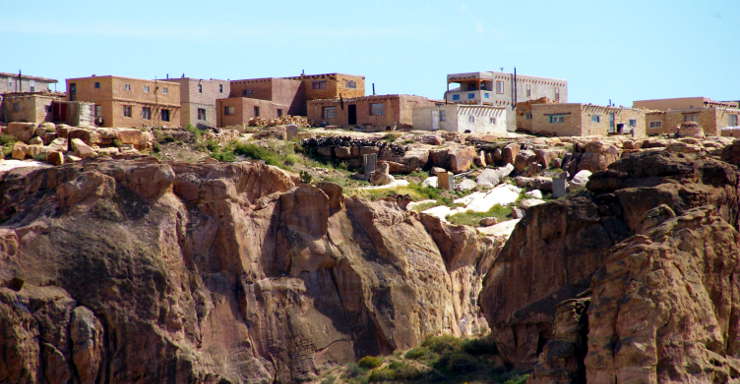
Houses in Acoma Pueblo atop the mesa
Bottom photo courtesy of Scott Catron, CCA-by-SA 2.0 License
